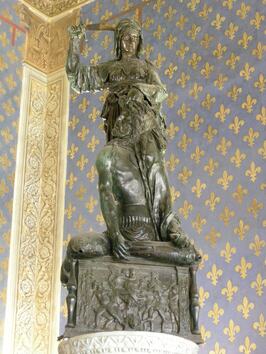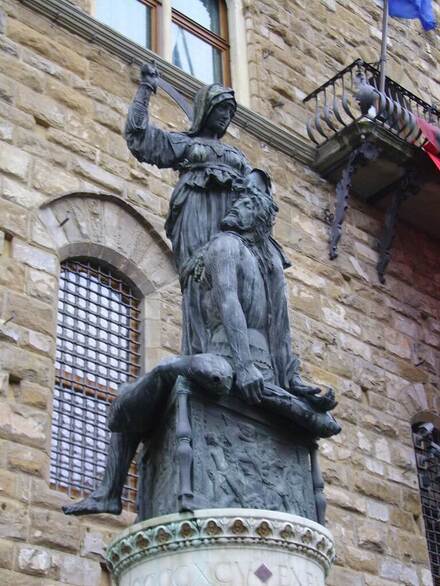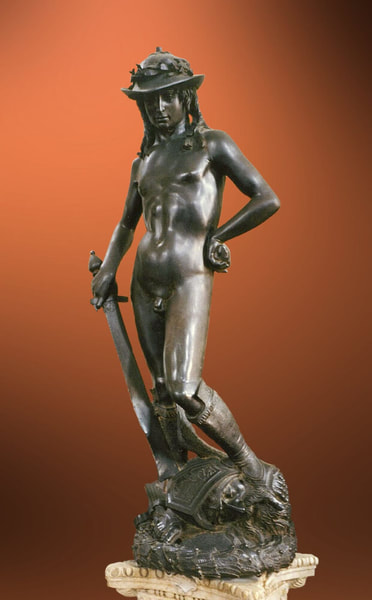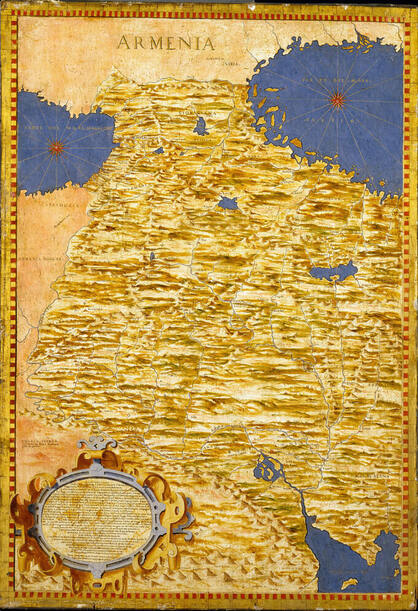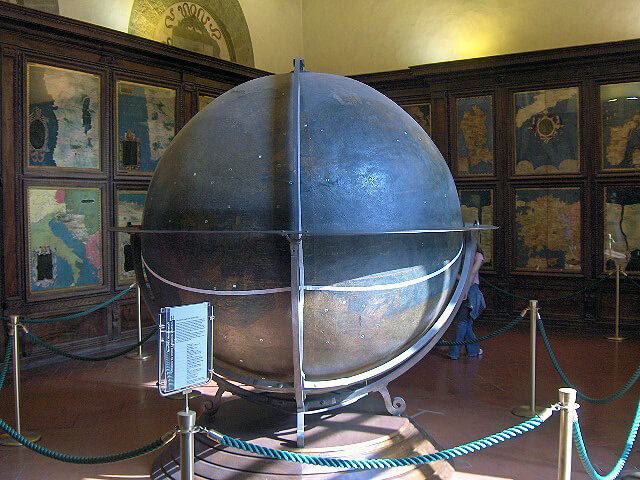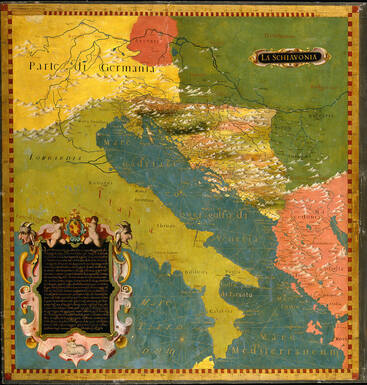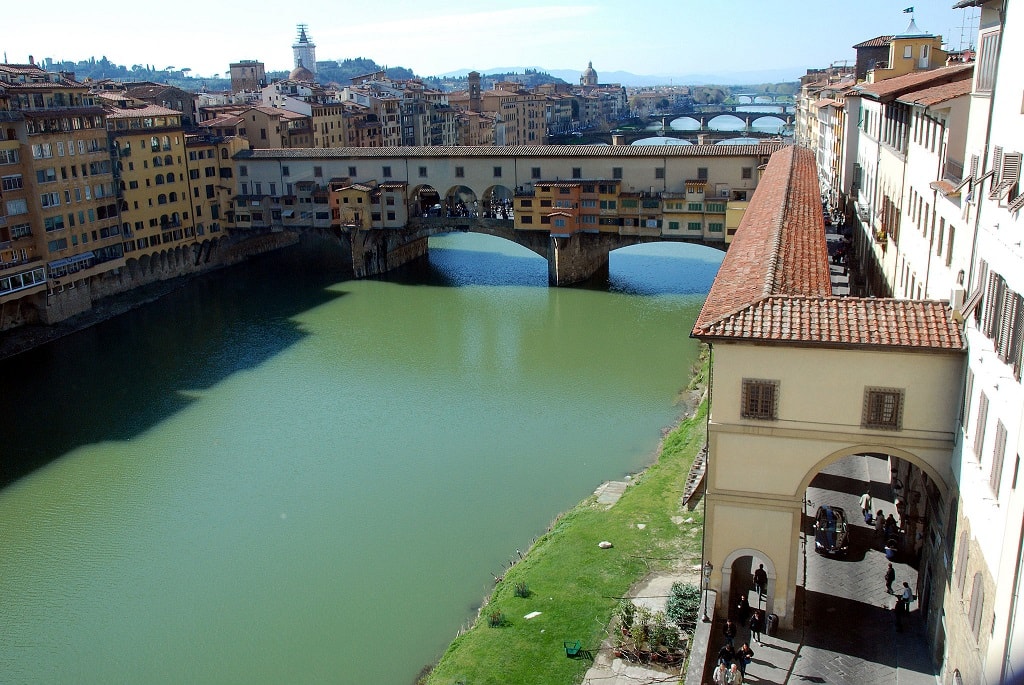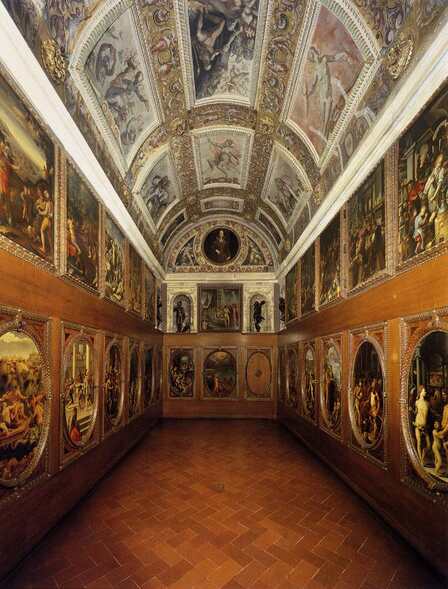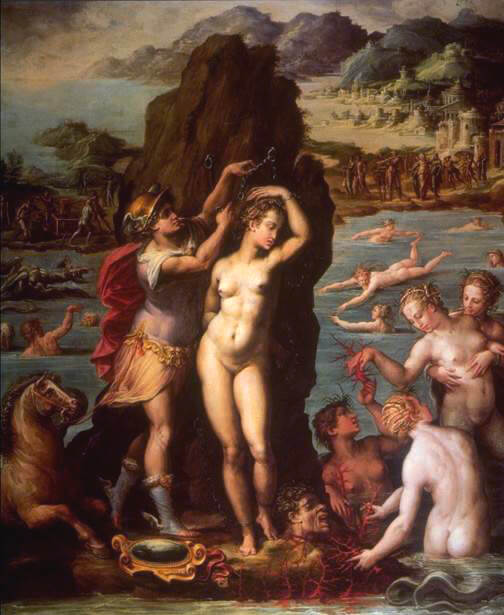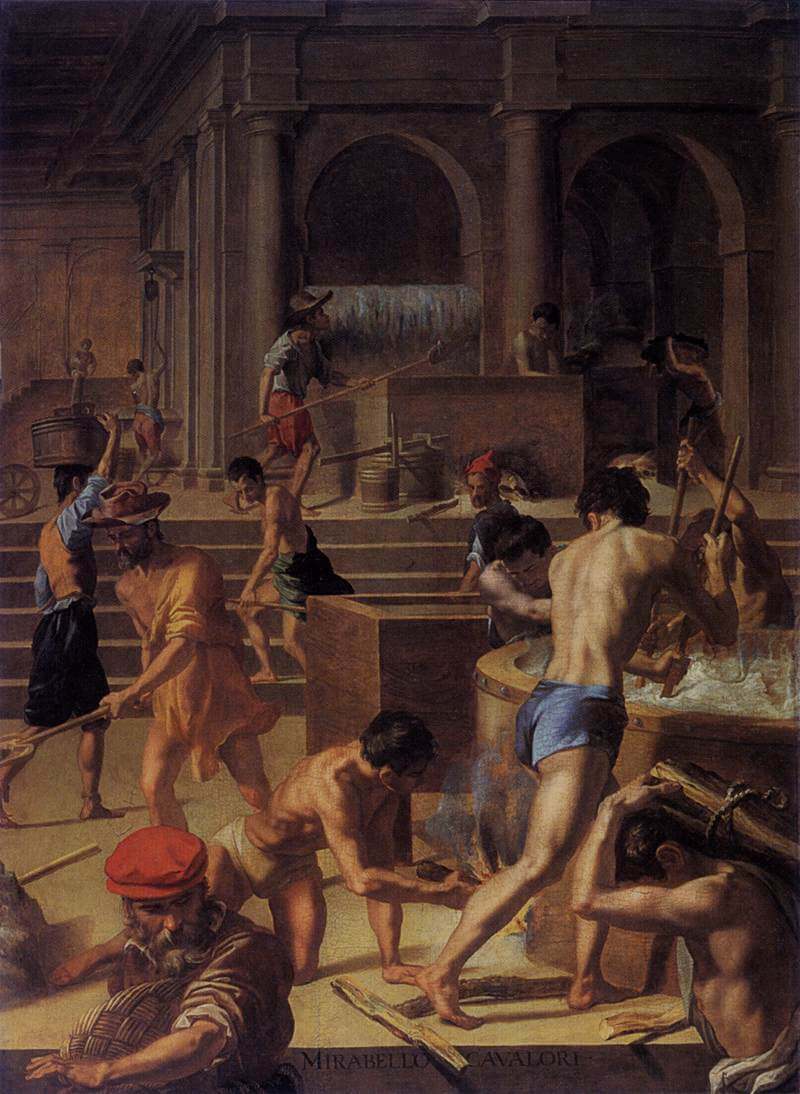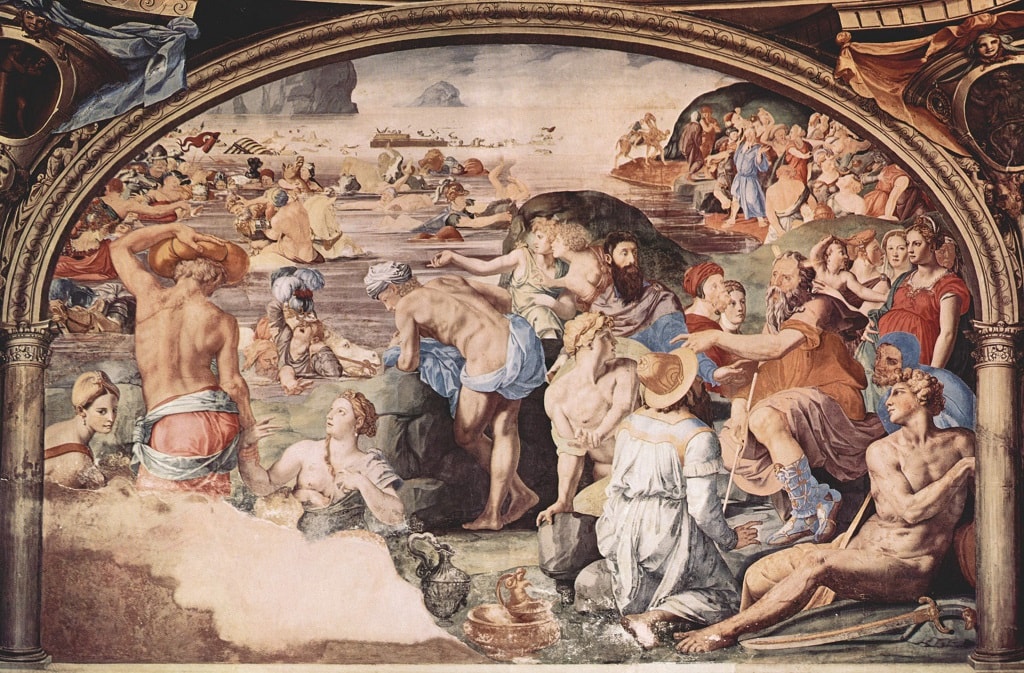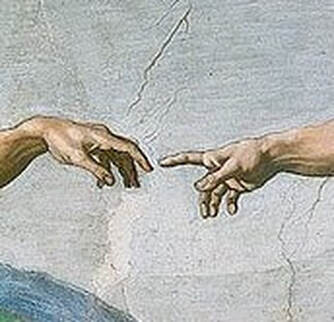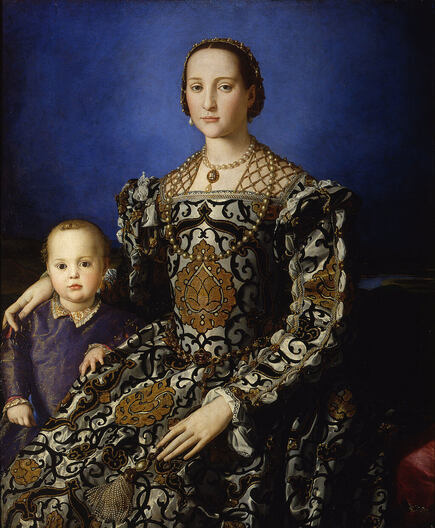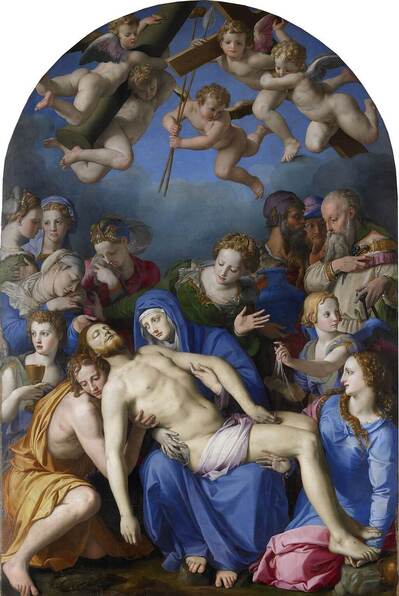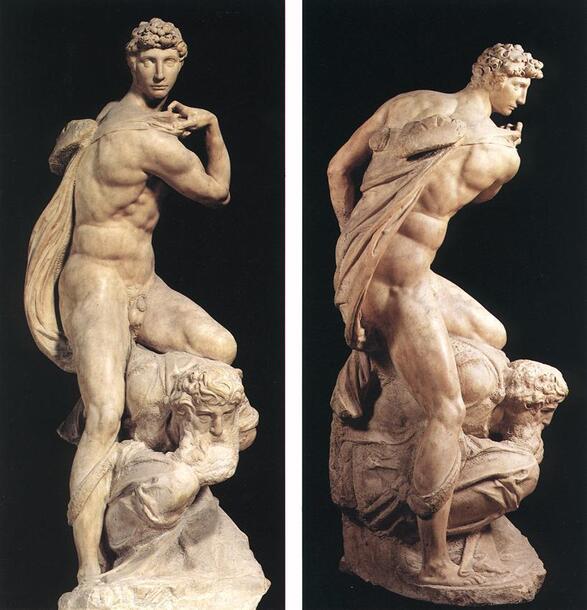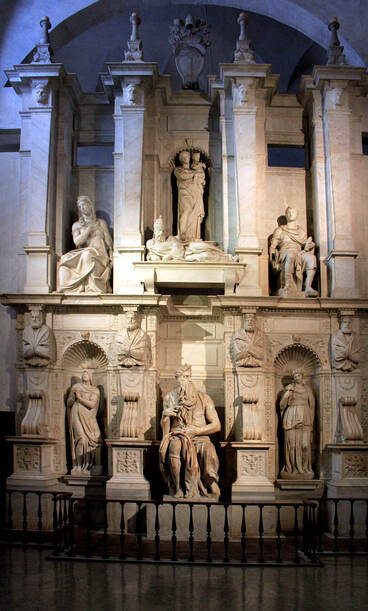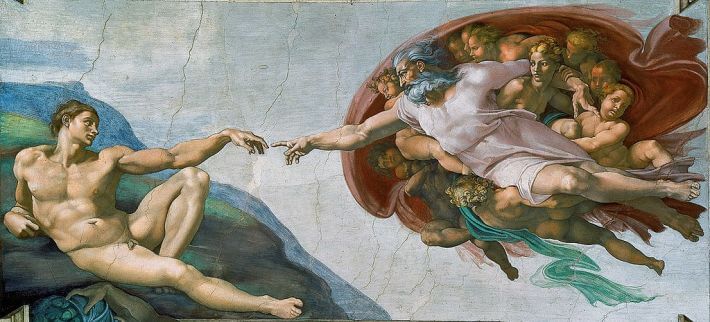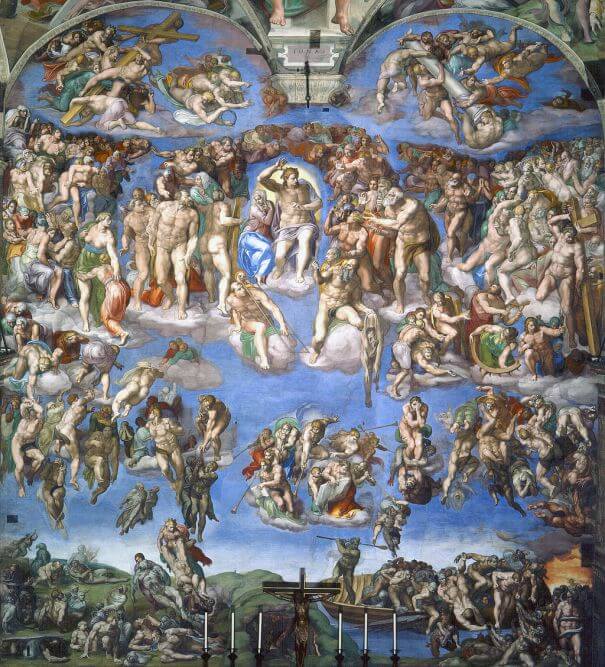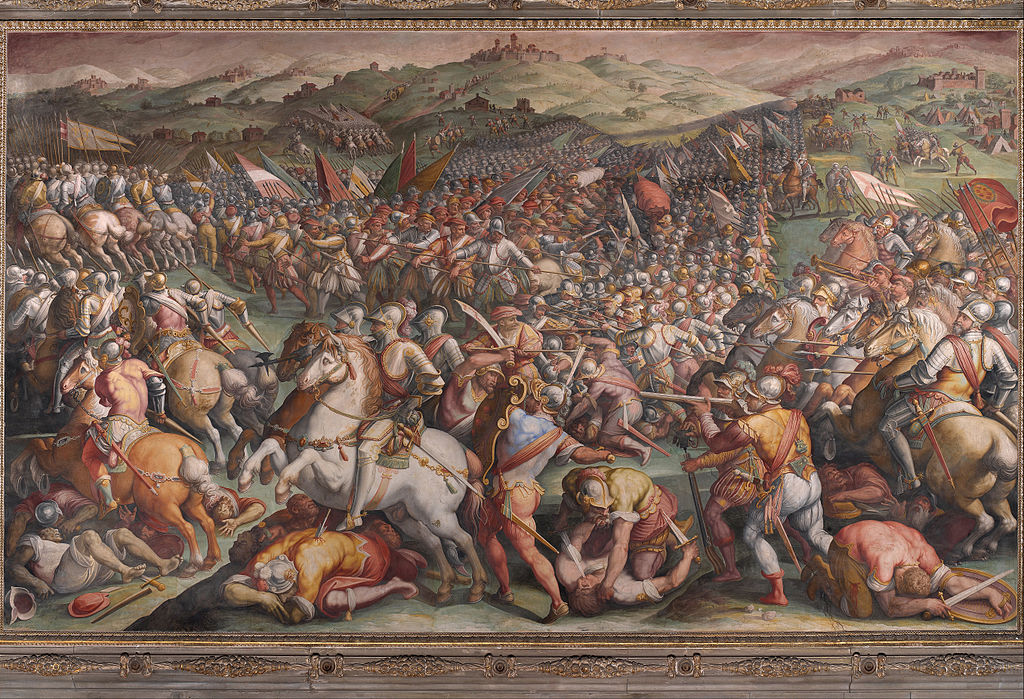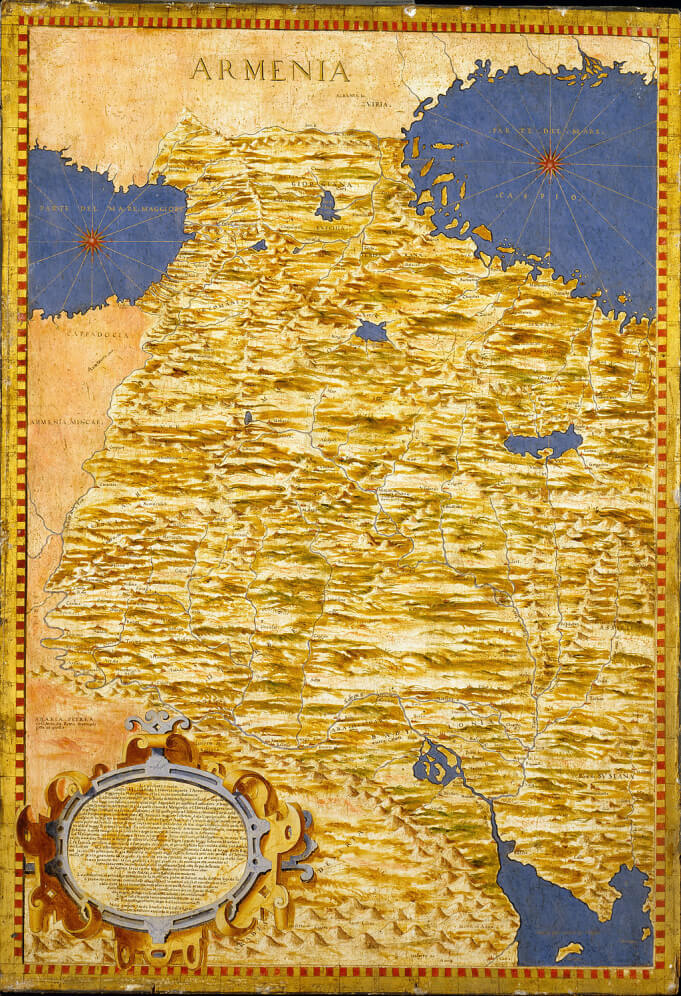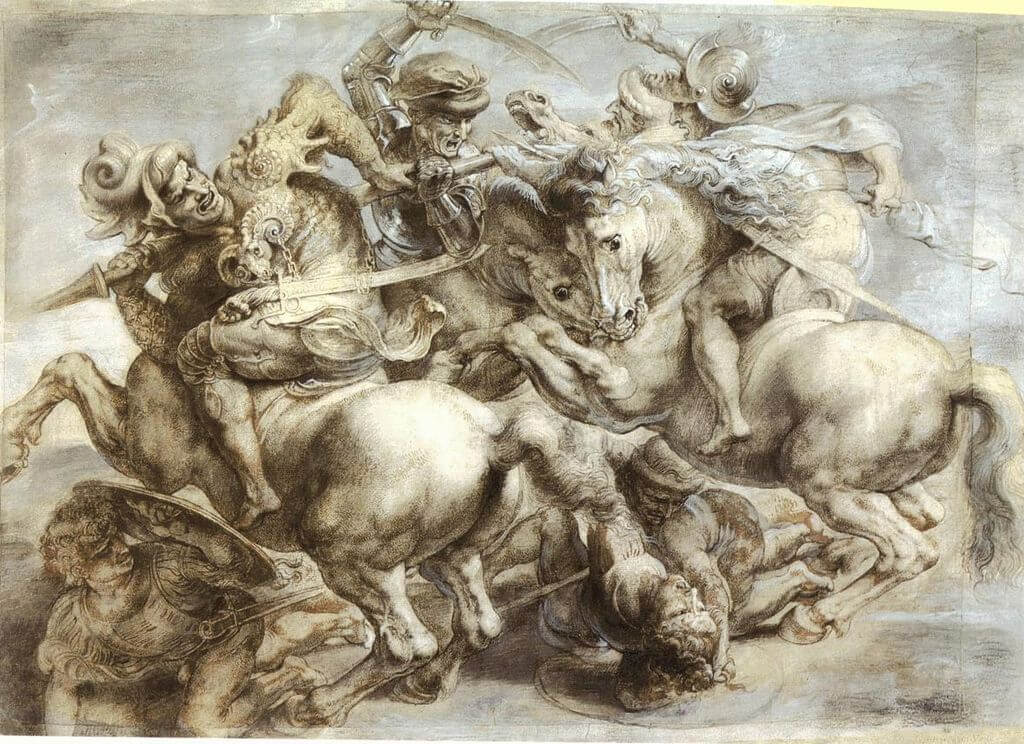|
Sailko, CC BY-SA 3.0
Where? Hall of Lilies (Sala degli Gigli) on the second floor of the Palazzo Vecchio
When? 1457-1464 Commissioned by? Cosimo de’ Medici What do you see? Judith, a beautiful Jewish widow, raises her sword to cut off the head of Holofernes, the general of the Assyrian army. She has already struck him once, which is why he looks already dead. She is holding the head of Holofernes by his hair. Judith seems to be in her thoughts, possibly still balancing the idea of killing Holofernes to protect the people from her city and violating one of the Ten Commandments (not to kill). At the same time, she is shown as a strong and fearless woman. Donatello sculpted her dress in a very realistic way. The dress looks a bit wrinkled as you may expect in this kind of scene, and it is beautifully hanging around her raised arm. The crushed body of Holofernes is laying at the feet of Judith. He looks like he is already dead, with his arms hanging unnaturally and his mouth wide open. Holofernes sits on a cushion, which bears the inscription “OPUS . DONATELLI . FLOR”, which means that this is the work of Donatello from Florence (it is the only work that Donatello signed). At the bottom of the statue, you can see some Bacchic scenes, which refer to the pride and lust of Holofernes. This bronze statue was originally gilded (painted in gold) and you can still see some of those gold remains on the sword of Judith. It is also one of the first “in the round” statues, in which you can look at the statue from all possible angles (see some pictures from different angles). A replica of this sculpture can also be found on the Piazza della Signoria in front of the Palazzo Vecchio.
Backstory: The story of Judith beheading Holofernes comes from the deuterocanonical book of Judith, chapters 10:13. Holofernes was a general in the Assyrian army and was planning to destroy the Jewish city in which Judith lived. The Jewish had no chance against the army of Holofernes and were considering to surrender. Judith was a beautiful woman and widow, and she heard about the plans of the people from her city to surrender. She decided to take matters into her own hands and goes to the camp of Holofernes’ army.
Judith convinces the Assyrians that she has reliable information on how they can conquer the whole Jewish region without casualties and she is allowed into their camp. She waits several days until Holofernes is drunk, seduces him with her beauty, and finally chops off his head when she is alone with him in his tent. She brings the head of Holofernes back to her city and devices a plan for the Jewish to kill the Assyrian army, in which they succeed. Symbolism: The sculpture shows that Judith, a simple widow, could triumph over a general from an army that was thought to be much stronger. The sculpture served as a symbol to the Florentine people to remember them that no matter how big the enemies of Florence could be, even the simplest members of society could help Florence to be triumphant. The granite base of the statue originally contained the following inscription: “Kingdoms fall through luxury [sin], cities rise through virtues. Behold the neck of pride severed by the hand of humility.” This inscription was ordered by the Cosimo de’ Medici referring to the Medici family as the defenders of the freedom of Florence. However, it was removed when the Medicis were exiled from Florence. Who is Donatello? Donatello (1386-1466) was born as Donato di Niccoló di Betto Bardi in Florence. He received his training in the workshop of a goldsmith and was also trained by Lorenzo Ghiberti. He was a sculptor who worked with various materials, including bronze, clay, stone, stucco, wax, and wood, and he created both self-standing sculptures and reliefs. After Michelangelo, many consider him to the second-best sculptor ever. Donatello’s most well-known work is the sculpture of David, which is now in the Bargello Museum. During his life, he worked and lived in Florence, Rome, Padua, and Siena.
Hall of Lilies: The walls of this room were to be decorated in 1482 by the greatest artists of that time (Biagio d’Antonia, Botticelli, Ghirlandaio, Perugino, and Piero del Pollaiolo). However, Domenico Ghirlandaio was the only one who painted a wall.
The middle of the wall depicts the deification of Saint Zenobius (the first bishop of Florence at the beginning of the 5th century). On the left and the right are characters from Roman history. The other artists backed out and instead the other walls were decorated with gold fleur-de-lys on a blue background. The fleur de lys (which means in French “lily flower”) is a stylized lily and was the symbol of the House of Plantagenet, a royal family from Anjou in France, who helped to protect the freedom of Florence. The lilies on the wall also explain the name of this room. The coffered ceiling with various ornaments and lilies and the frieze below the ceiling, which is full of lions, is created by Giuliano da Maiano. The portal connecting this room with the Audience Hall is created by the brothers Benedetto and Giuliano de Maiano. Fun fact: Little has been written about the life of Donatello, so most information about him is inferred from his work. This provides room for endless speculation as the works of Donatello were very unconventional for his time (nowadays the word unconventional has been replaced by innovative). Donatello was supposedly openly gay and had an unpleasant personality. However, he was a friend of the Medici family, which ensured him a lifelong guarantee of assignments (and he, supposedly, never rejected an assignment, however small it was). He would make whatever the Medicis asked him and therefore the Medicis could use him not only to create beautiful art but also to express the ideas of the Medici family. Interested in a copy for yourself? Framed poster (Amazon link)
0 Comments
Where? Room on the Second Floor of the Palazzo Vecchio
When? 1561-1565 Commissioned by? Duke Cosimo I de’ Medici Designed by? Giorgio Vasari designed the room in conjunction with cosmographer Fra’ Miniato Pitti. Egnazio Danti completed the painting of the map of Armenia. What do you see? This room shows the world as known in 1563. It was supposed to show both the terrestrial view (the maps of the countries in the world) and the celestial view (the map of the sky). Nowadays, this hall provides dozens of geographical maps painted on leather. The maps range from Japan to Brazil, and from the North Pole to the South Pole. More precisely, the room houses 53 maps. The first 30 have been completed by Egnazio Danti while Duke Cosimo I was still alive. After his death, the son of Cosimo I, Francesco I, hired Stefano Bonsignori to complete the remaining 23 maps. The maps are very precise, based on the knowledge of that time, and contain impressive details, including information about the wind and other typical features of each territory. In the middle of the room stands the largest rotating globe of its era, created by Matteo Neroni in 1567. Finally, the ceiling was supposed to be decorated with the 48 constellations but has never been completed.
Backstory: Duke Cosimo I de’ Medici asked Vasari to design this room that would show the whole world as known at that time. The room also contained many of the most valuable objects that the Medici family collected, stored in large cupboards made of walnut wood. These objects included scientific instruments, small statues, and tapestries. The maps were created on top of the cupboard doors. The room also served the purpose of celebrating the duke as the lord of the universe. This may be related to his name Cosimo, which was his birth name, and which was derived from the Greek word ‘kosmos’, which means 'universe'.
Who is Duke Cosimo I de’ Medici? Cosimo I de’ Medici (1519-1574) was born in Florence and was the Duke of Florence from 1537-1569, after which he became the Grand Duke of Tuscany until his death. Cosimo was part of a rich banking family that was already a political dynasty since the 14th century. Cosimo was very interested in geography, natural sciences, and trade. Like his ancestors, he was an important supporter of the development and preservation of art during his life. For example, he has given Giorgio Vasari the task to create the building of the Uffizi Museum and the Vasari Corridor. However, Cosimo also commissioned the Palazzo Pitti and the Boboli gardens.
Who is Giorgio Vasari? Giorgio Vasari (1511-1574) was an architect, historian, painter, and writer. He is best known for his book (Amazon link) describing the lives of many of the most well-known Renaissance artists. He has been instrumental in the design of the Palazzo Vecchio as we experience it today. He was involved in the design of many of the elements of the palace, including the Hall of the Five Hundred, the staircase leading up to the Hall of the Five Hundred, the Studiolo of Francesco I, and the staircase up to the second floor.
Fun fact: The Palazzo Vecchio is full of secret entrances and hidden rooms. Behind the map of Armenia, there is a secret door that leads to a private studio. This studio served multiple purposes over time. It has been used by the inhabitants of the palace to bring their lovers for some intimacy, but also to torture their enemies. The studio leads to a stairway with a small opening where corpses could conveniently be dumped in the nearby river. While these kinds of hidden studios were typically reserved for the male inhabitants, it was initially used by Duchess Bianca Cappello, the daughter-in-law of Cosimo I, who secretly married to Cosimo’s son Francesco I. Interested in a copy for yourself? A short book with illustrations from the maps in this room (Amazon link)
Where? A small room connected to the Hall of the Five Hundred in the Palazzo Vecchio
When? 1570-1572 Commissioned by? Francesco I de’ Medici Created by? Giorgio Vasari in collaboration with Vincenzo Borghini and Giovanni Batista Adriani What do you see? The most extravagant room in the Palazzo Vecchio is the Studiolo of Francesco I. It is completely decorated with paintings and sculptures. Most of the paintings and sculptures in this room are related to the four elements. Let’s highlight several of thes artworks in this room:
Backstory: This room was created for Francesco I de’ Medici who wanted to surround himself with the things he loved, which was pursuing his interests in chemistry and alchemy. The room was part of the private apartment of Francesco I and could be accessed only from his bedroom. That entrance was on the opposite side of the room from the current entrance, which is on the side of the Hall of the Five Hundred and did not exist around that time.
Francesco I used this room as a cabinet of curiosities to store rare items, including natural items and stones, which he collected while traveling the world. He stored this collection in about 20 cabinets that filled up the walls of the room. Each cabinet was decorated with a painting that represented what could be found inside. Unfortunately, none of these rare items has been preserved. Symbolism: The four walls of the Studiolo are associated with the four elements: air, earth, fire, and water. This theme was inspired by Francesco’s interest in nature. Each of the walls represents one theme. The wall where you enter the room represents earth and the short wall on the opposite end represents air. The wall on the left represents water and the wall on the right fire. Who is Francesco I de’ Medici? Francesco I de’ Medici (1541-1587) was the second Grand Duke of Tuscany and successor to his father Cosimo I de’ Medici. He was in charge of Tuscany from 1574-1587. Just like his father he had a great interest in art and continued to support the great artists of his time. He was also very interested in science and nature, especially alchemy and chemistry. Who is Vasari? Giorgio Vasari (1511-1574) was an architect, historian, painter, and writer. He is best known for his book describing the lives of many of the most well-known Renaissance artists (Amazon link to the book). His colleagues regarded him as a great architect. He played an important role in the design of the Hall of the Five Hundred and is also known from his design of the Vasari Corridor and the Uffizi Museum.
Fun fact: The Palazzo Vecchio has many secrets, such as hidden rooms, secret staircases, and secret spaces in the roof of the Hall of the Five Hundred. One of those secret entrances can be found in the Studiolo. The entrance from the Hall of the Five Hundred only opened in the 19th century and the original entrance is on the other side of the room (it is the panel without a painting). This secret entrance or exit leads to the bedroom of the Duke. If you are interested in these secrets, you can book a tour that covers these secret passages.
Where? The Private Chamber of Eleanor in the Palazzo Vecchio
When? 1541-1542 Commissioned by? Cosimo I de’ Medici and/or his wife Eleanor of Toledo. What do you see? This fresco shows three different scenes related to the biblical story of the Jews that escaped from Egypt where they were repressed. First, the three young people in the center foreground and the three people in the left foreground represent the Jews that were preparing to escape from Egypt (note that the bottom left of the painting is missing due to damage from moisture). For example, the man on the left has some unleavened bread on his head which the Jews took with them when escaping Egypt. You can also see a silver jug and a gold basin from the Egyptians in the foreground. Second, the fresco shows the escape from the Jews from Egypt by crossing the Red Sea. In the top right you can see the Jews who safely crossed the Red Sea after God opened it up for them. If you look carefully, you can see that one of the Jews on top who still has the unleavened bread on his head. The man among the Jews in the blue robe is Moses. In the sea on the left, you can see the Egyptians and their horses getting drowned while they were chasing the Jews.
Backstory: In 1539, Cosimo I, Duke of Florence, married to Eleanor of Toledo and in 1540 they moved into the Palazzo Vecchio. At that moment the Palazzo Vecchio was not decorated like a palace that could impress its guests, so Cosimo I commissioned several artists to decorate the palace. This fresco was painted for the private room (also referred to as the chapel) of Eleanor of Toledo, which was one of the first rooms in the Palazzo Vecchio to be decorated.
The story in the painting contains both the beginning and the end of the story of Moses in the Bible. In the beginning, he leads the Jews through the Red Sea to get out of Egypt where they were repressed (see Exodus 14). After that, the Jews wandered for 40 years through the desert before they could see their promised land. Before entering the Promised Land, Moses passed on his leadership to Joshua (see Numbers 27), and Moses died with the Promised Land in sight. Symbolism: This painting contains various allusions to Cosimo I and his wife, Eleanor. Moses alludes to Cosimo I, who wants to be perceived as a new Moses; someone who leads his people to new heights. The crossing of the Red Sea by the Jews alludes to the 1537 battle of Cosimo I at Montemurlo, in which he ended all opposition to the Medici family as rulers of Florence. The appointment of Joshua by Moses refers to the birth in 1541 of Francesco, the son of Cosimo I and Eleanor, who had to succeed Cosimo I. Who is Eleanor of Toledo? She was the Duchess of Florence from 1539 till 1562. Eleanor of Toledo (1522-1562) was born in Alba de Tormes in Spain and was the first wife of Cosimo I, who was the second Duke of Florence and became the first Grand Duke of Tuscany in 1569. The marriage between the two was a political marriage as it strengthened the position of the Medici family. She got 11 children with Cosimo I and they had a faithful and good marriage. Bronzino painted a well-known portrait of Eleanor and one of her sons which is on display in the Uffizi Museum in Florence.
The Private Chamber of Eleanor: This room was used by Eleanor to escape the hustle and bustle of everyday life and to pray to God. It contains several frescos.
Who is Bronzino? Agnolo di Cosimo (1503-1572) was born near Florence and is better known as Bronzino. He is one of the most important painters in the Mannerist movement in the 16th century. He was a big fan of the works of Raphael and Michelangelo. He was an excellent portrait painter but also painted many biblical scenes. He was the court painter of the Medici Family when Cosimo I was in charge of Florence.
Despite his talents, he is somewhat less popular than some of the other famous painters of his time. The main reason is that the paintings of Bronzino lack drama and dynamism. The figures that he paints often lack emotions and are depicted in a calm state. For example, look at the lack of drama in the very calm sea in which the Egyptians are drowning in this painting. Fun fact: Bronzino included several (almost) naked people among the Jews, including the figure in the right foreground. The ancient Greek statues inspired the shapes of these nudes. The person in blue to the left of Moses in the foreground is a self-portrait of Bronzino. The lady on the right with her hand on her belly is probably Eleanor who was pregnant. She was pregnant with Francesco, who would succeed Cosimo I and ensure the continuation of the Medici family as rulers of Florence. Francesco was born on March 25, 1541, which was the day on which the founding of Florence was celebrated. The timing of his birth was not considered a coincidence and exploited by the Medicis as a sign that Francesco was destined to be the new leader of Florence.
Where? Hall of the Five Hundred in the Palazzo Vecchio
When? 1532-1534 Commissioned for? The tomb of Pope Julius II What do you see? Two male figures. A vigorous young man is standing with a crown of oak leaves and is holding a sling. The body is twisted in an extreme way, but Michelangelo makes it look like a comfortable position. The body of the young man is finished to perfection. In contrast, at the feet of the young man is an old and wrinkled conquered warrior. The knee of the young man seems to push hard onto the head of the old man. The sculpture is unfinished at the bottom, which allows you to admire the sculpting techniques of Michelangelo. More about Michelangelo’s sculpting techniques can be learned in this video. Backstory: Michelangelo made this sculpture of almost 9 feet tall (2.61 meters) for the tomb of Pope Julius II (1443-1513). He was the Pope from 1503 until his death in 1513. Pope Julius II was also known as the ‘Warrior Pope,’ as he was very active to make the papacy the most dominant military and political force in Italy. This is also the reason that a statue of a victorious young man seems fitting for his tomb after his death. It is also no coincidence that Michelangelo was asked to create this statue as Pope Julius II was the one that commissioned Michelangelo’s famous frescos at the ceiling of the Sistine Chapel. Symbolism: The oak leaves in the crown of the standing man refer to the emblem of the house of Della Rovere (which means ‘of the oak tree’), a noble Italian family that produced two popes. Several interpretations have been given to the statue, but one of the popular ones is that this statue is an allegory of the victorious overlooking the defeated. Why the tomb of Pope Julius II? In 1505, Pope Julius II commissioned Michelangelo to create the Pope’s tomb for after his death. The original idea was to create a freestanding tomb seven meters wide, eleven meters deep, and eight meters high, with about 40 statues. However, due to a lack of funding and people convincing the pope that it was bad luck to have his tomb built while he was still alive, the project got delayed. After the death of the Pope, the project got gradually less ambitious, and the final tomb includes substantially fewer statues and is not freestanding anymore. The tomb can be found in the San Pietro in Vincoli Church in Rome.
Who is Michelangelo? Michelangelo di Lodovico Buonarroti Simoni (1475-1564) was an architect, engineer, painter, poet, and sculptor. He is considered to be one of the greatest artists ever and was considered the best artist of his time. He is probably most well-known for his sculptures (think about the David and the Pietà) and his frescos in the Sistine Chapel such as the Creation of Adam and The Last Judgment.
Fun fact: The standing young man in this statue is believed to be Tomasso dei Cavaleiri. Michelangelo was 57 when he met Cavaleiri, who was 23 at that time, and fell in love with him. Michelangelo dedicated 30 poems to Cavaleiri in which he expressed his love for him and also used him as inspiration for some of his other works. They remained lifelong friends, even though, Cavaleiri married in 1538 and got two children with someone else. The adoration of the male body was not completely uncommon during the Renaissance. Leonardo da Vinci also showed this appreciation in his work.
Where? Hall of the Five Hundred in the Palazzo Vecchio
When? 1565 Commissioned by? Duke Cosimo I de’ Medici What do you see? The battle of Marciano is a bloody battle between the Republic of Siena and Florence, which was won by the Florentine. In the foreground, several explicit scenes are depicted of people getting killed in man-to-man battles. The rest of the fresco shows the battle between the large armies of Florence and Siena. Backstory: This fresco is also known as the Battle of Scannogallo (which was a creek near the village of Marciano della Chiana). The fresco marks the victory of the Florentine army over the army of Siena. The Florentine army worked together with the Spanish army, while the Republic of Siena got help from the French army. Both sides had a total of about 15 thousand soldiers that day. While on the Florentine side only 200 people got killed, the Siena side suffered losses of 4,000 with an additional 4,000 people captured. Why the Battle of Marciano? The battle of Scannagallo took place on August 2, 1554. It was a battle between the Florentine army under the command of Gian Giacomo Medici (following orders of Duke Cosimo I de’ Medici) and the Siena army under the command of Piero Strozzi. The goal of Duke Cosimo I de Medici was to get complete control of Tuscany, and for that, the Republic of Siena had to be conquered. This battle was a very important event in the decline of the Republic of Siena, and in 1559 they finally surrendered to Florence. Who is Vasari? Giorgio Vasari (1511-1574) was an architect, historian, painter, and writer. The paintings in the Hall of the Five Hundred are considered to be one of his best paintings. He was also the creator of the Hall of Geographical Maps which is also in the Palazzo Vecchio. Vasari was also a very successful architect and his work includes the construction of the Uffizi Museum and the Vasari Corridor in Florence. However, he is most famous nowadays for his book e Vite de’ più eccellenti pittori, scultori, e architettori da Cimabue insino a’ tempi nostril, translated as Lives of the Most Excellent Painters, Sculptors, and Architects, from Cimabue to Our Times, which documents the history of the Italian Renaissance (Amazon link to the book).
Dan Brown: This painting plays an important role in the book Inferno by Dan Brown (Amazon link to the book). On a green flag in the top middle of the fresco the words ‘cerca trova’ are written, which means ‘seek and ye shall find’. Without binoculars, it is almost impossible to see this.
The green flags belonged to the Siena army and they used to include different verses of Dante on them for inspiration. Duke Cosimo I wanted the sentence ‘cerca trova’ to be included in the painting as an ironic reference to the ‘defeat’ that the Siena army found. In Dan Brown’s book Inferno the words ‘cerca trova’ play an important role and lead the main character Robert Langdon to the death mask of Dante. What is a Fresco? A fresco is a painting that is executed using the fresco technique. This technique paints directly on wet lime plaster (a mix of sand, water, and lime that becomes solid when it dries). After the pigment is applied to the wet plaster and the plaster dries, the painting becomes an integral part of the wall. A mural is a more general word than a fresco as murals can also be created using different techniques. Fun fact: It has long been believed by many that below the fresco of Vasari a famous fresco of Leonardo da Vinci can be found. In 1505 Leonardo da Vinci completed a fresco called The Battle of Anghiari. This fresco is referred to as the ‘lost Leonardo’ and preparatory sketches from Leonardo for this fresco and copies by later artists, such as Peter Paul Rubens, serve as evidence for the existence of this fresco. There are three reasons to believe that the lost Leonardo may indeed still be hidden here.
Interested in a copy for yourself? Poster or Canvas |
Categories
All
|
- Home
- Blog
-
Museums
- Alte Pinakothek
- Art Institute of Chicago
- Baltimore Museum of Art
- Barber Institute of Fine Arts
- Bargello
- Barnes Foundation
- British Museum
- Church of Sant’Anastasia
- Cleveland Museum of Art
- Courtauld Institute of Art
- Detroit Institute of Arts
- Frans Hals Museum
- Galleria Borghese
- Gallerie dell'Accademia
- Getty Museum
- Guggenheim
- Hermitage Museum
- Kunsthistorisches Museum
- Kunstmuseum Basel
- Legion of Honor Museum
- Louvre
- Mauritshuis
- Metropolitan Museum of Art
- Musee d’Orsay
- Museum of Fine Arts in Boston
- Museum of Modern Art
- National Gallery in London
- National Gallery of Art
- National Museum in Poznań
- Norton Simon Museum
- Ny Carlsberg Glyptotek
- Palace of Versailles
- Palazzo Pitti
- Palazzo Vecchio
- Petit Palais
- Philadelphia Museum of Art
- Prado
- Pushkin Museum
- Ravenna Art Museum
- Rijksmuseum
- San Diego Museum of Art
- Santa Maria delle Grazie
- St. Peter's Basilica
- Städel Museum
- Statens Museum for Kunst
- Tate Britain
- Tate Modern
- Timken Museum of Art
- Uffizi
- Vatican Museums
- Wallace Collection
-
Artists
- Altdorfer
- Anguissola
- Berlin Painter
- Bosch
- Botticelli
- Boucher
- Bronzino
- Bruegel the Elder
- Brunelleschi
- Cabanel
- Caillebotte
- Canova
- Caravaggio
- Carpeaux
- Cezanne
- Cimabue
- David
- Degas
- Delacroix
- De Maria
- Donatello
- El Greco
- Fontana
- Fra Angelico
- Fragonard
- Gauguin
- Gentileschi
- Gericault
- Gonzalez-Torres
- Goya
- Hals
- Hogarth
- Hokusai
- Ingres
- Leonardo da Vinci
- Lippi, Filippo
- Longhi, Barbara
- Lorrain
- Makovsky
- Manet
- Massys
- Matisse
- Merian
- Michelangelo
- Mochi
- Modigliani
- Monet
- Panini
- Parmigianino
- Perugino
- Picasso
- Pisanello
- Raphael
- Rembrandt
- Renoir
- Reynolds
- Rivera
- Rodin
- Rubens
- Scultori
- Seurat
- Steen
- Tintoretto
- Titian
- Toulouse-Lautrec
- Turner
- Uccello
- Van der Weyden
- Van Dyck
- Van Eyck
- Van Gogh
- Van Hemessen
- Vasari
- Velazquez
- Vermeer
- Veronese
- Vigée Le Brun
-
Locations
- Books
- About Us

